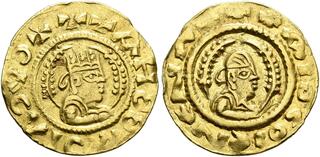Lot description:
Kaleb, circa 510-530s. Chrysos (Gold, 17 mm, 1.53 g, 12 h). ✠✠✠ΑΗB ᗺMↃIΛↃYↃ Draped half-length bust of Kaleb to right, wearing tiara and circular earring, holding spear in his right hand and with bracelets on his right arm; to left and right, ears of barley; all within circular border. Rev. ✠✠✠AIOC OICNЄNΛ Draped half-length bust of Kaleb to right, wearing tight-fitting head cloth and circular earring, holding branch in his right hand and with bracelets on his right arm; to left and right, ears of barley; all within circular border. Hahn, Aksumite, 41c. Hahn & Keck, MAKS, 65.16 (this coin). A. Kammerer: Les monnaies abyssines de la collection Muncharjee d'Aden, RN (1926), pl. III, 8 = Phaidra 1190406 (this coin). Munro-Hay, AC, type 102 (this coin cited). Light marks, otherwise, very fine.
From the Dr. Stephan Coffman Collection, ex Baldwin's FPL, Summer 2017, 88, from the Joan Wilde Collection, Classical Numismatic Group 99, 13 May 2015, 916, ex Morton & Eden, 23 November 2004, 703, and from the collection of Kaikee Muncharjee.
With the reign of Kaleb, the Axumite Kingdom again enters the light of historiography. Both Byzantine and Islamic sources (notably Procopius, De bell. 1.20.1-8) report that under Kaleb, a Christian king was installed in the Himyarite Kingdom in circa 518, but that he was toppled by Yusuf Dhu Nuwas, a Jewish convert, who pursued a decidedly anti-Christian (and thus anti-Axumite and anti-Byzantine) course. The massacre of the Christian community at Najran in particular greatly impressed the Christian world, and Kaleb invaded southern Arabia once more in circa 525 with approval of the Byzantine emperor, Justin I (although Procopius rather paints Justinian I as the instigator), sweeping away the forces of Yusuf and installing a new local client king named Sumuyafa Ashwa, who was promptly baptized.
The conquest would not prove durable, however, as a revolt of Ethiopian troops stationed in Himyar during the next decade saw a certain Abreha rise to power. Though Kaleb attempted to reassert Axumite authority, his attempts were ultimately in vain. His reign would be Axum's swan song, as the kingdom's power and prosperity appear to have steadily declined over the following decades. He is said to have abdicated, dedicating his crown to the Church of the Holy Sepulchre in Jerusalem and entering a monastery. After his death, Kaleb was canonized, and he is still venerated as Saint Elesbaan in the Orthodox Church today.
Interestingly, Kaleb's chrysoi carry a filiation ('YIOC ΘЄΖΑΝΑ' = 'Son of Thezana'), a unique phenomenon in Axumite coinage. It is not entirely clear who this Thezana was - it could be another name of Nezana/Nezool, meaning that Kaleb was of royal blood, or a wholly unknown individual who did not reign at all. If the former is true, Kaleb apparently did not directly succeed his father, perhaps because he was still a minor when the king died. Such a course of events might explain the appearance of his unusual coin legends, which underlined his claim to power through noble parentage.
Starting price: 150 CHF |  |